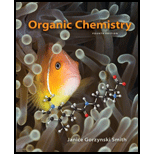
Concept explainers
(a)
Interpretation: Synthesis of each of the following compound from (CH3)2CHCH2CH2Br is to be devised.
Concept introduction: Dehydrohalogenation is a
(b)
Interpretation: Synthesis of each of the following compound from (CH3)2CHCH2CH2Br is to be devised.
Concept introduction: Dehydrohalogenation is a chemical reactions which involves the removal of a hydrogen halide from an alkyl halide to furnish alkenes. The reacting alkyl halide must be able to form an alkene, which means they should have a replaceable hydrogen (Β-hydrogen). Some of the alkyl halides are unsuitable such as benzyl halides and aryl halides.
(c)
Interpretation: Synthesis of each of the following compound from (CH3)2CHCH2CH2Br is to be devised.
Concept introduction: Dehydrohalogenation is a chemical reactions which involves the removal of a hydrogen halide from an alkyl halide to furnish alkenes. The reacting alkyl halide must be able to form an alkene, which means they should have a replaceable hydrogen (Β-hydrogen). Some of the alkyl halides are unsuitable such as benzyl halides and aryl halides. Halohydrin reaction is addition reaction of one Br and one OH to an alkene to form a hydroxyl derivative with alpha substituted halide.
(d)
Interpretation: Synthesis of each of the following compound from (CH3)2CHCH2CH2Br is to be devised.
Concept introduction: Halogenation is a chemical reaction which involves the addition of one or more halogens to a compound such as alkene or
(e)
Interpretation: Synthesis of each of the following compound from (CH3)2CHCH2CH2Br is to be devised.
Concept introduction: Epoxidation (or oxirane synthesis) is a chemical reaction in which an alkene in reacted with peroxide to give an epoxide. An epoxide is a cyclic ether with a three-atom ring having an equilateral triangle structure. Since, the three membered ring is highly strained (Baeyer strain), many
Want to see the full answer?
Check out a sample textbook solution
Chapter 10 Solutions
Organic Chemistry-Package(Custom)
- Explain how, based on physical gas adsorption isotherms, we can determine whether multi-walled C nanotubes are open at their ends. Explain this.arrow_forwardcan somone answer pleasearrow_forwardConstruct a molecular orbital energy-level diagram for BeH2. Sketch the MO pictures (schematic representation) for the HOMO and LUMO of BeH2 [Orbital Potential Energies, H (1s): -13.6 eV; Be (2s): -9.3 eV, Be (2p): -6.0 eV]arrow_forward
- Indicate the isomers of the A(H2O)6Cl3 complex. State the type of isomerism they exhibit and explain it briefly.arrow_forwardState the formula of the compound potassium μ-dihydroxydicobaltate (III) tetraoxalate.arrow_forwardConsider the reaction of the cyclopentanone derivative shown below. i) NaOCH2CH3 CH3CH2OH, 25°C ii) CH3!arrow_forward
- What constitutes a 'reference material', and why does its utilization play a critical role in the chemical analysis of food products? Provide examples.arrow_forwardExplain what calibration is and why it is essential in relation to food analysis. Provide examples.arrow_forwardThe cobalt mu-hydroxide complex cobaltate(III) of potassium is a dinuclear complex. Correct?arrow_forward
- The cobalt mi-hydroxide complex cobaltate(III) of potassium is a dinuclear complex. Correct?arrow_forward3. Arrange the different acids in Exercise B # 2 from the strongest (1) to the weakest acid (10). 1. 2. (strongest) 3. 4. 5. 6. 7. 8. 9. 10 10. (weakest)arrow_forwardName Section Score Date EXERCISE B pH, pOH, pка, AND PKD CALCULATIONS 1. Complete the following table. Solution [H+] [OH-] PH РОН Nature of Solution A 2 x 10-8 M B 1 x 10-7 M C D 12.3 6.8 2. The following table contains the names, formulas, ka or pka for some common acids. Fill in the blanks in the table. (17 Points) Acid Name Formula Dissociation reaction Ka pka Phosphoric acid H₂PO₁ H3PO4 H++ H₂PO 7.08 x 10-3 Dihydrogen H₂PO H₂PO H+ HPO 6.31 x 10-6 phosphate Hydrogen HPO₁ 12.4 phosphate Carbonic acid H2CO3 Hydrogen HCO 6.35 10.3 carbonate or bicarbonate Acetic acid CH,COOH 4.76 Lactic acid CH₂CHOH- COOH 1.38 x 10 Ammonium NH 5.63 x 10-10 Phenol CH₂OH 1 x 10-10 Protonated form CH3NH3* 3.16 x 10-11 of methylaminearrow_forward
 Organic ChemistryChemistryISBN:9781305580350Author:William H. Brown, Brent L. Iverson, Eric Anslyn, Christopher S. FootePublisher:Cengage Learning
Organic ChemistryChemistryISBN:9781305580350Author:William H. Brown, Brent L. Iverson, Eric Anslyn, Christopher S. FootePublisher:Cengage Learning
